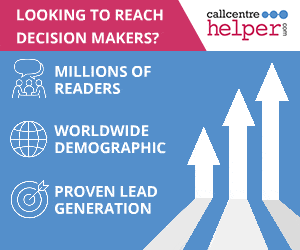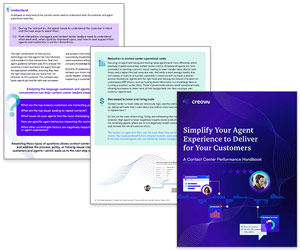Quality assurance (QA) and call recording remain core pillars of contact centre performance, but the tools and standards surrounding them are advancing quickly. This means keeping pace is more essential than ever before!
So, how do contact centre leaders deliver consistent customer experiences and maintain compliance in this ever-changing space? We asked the experts to find out.
Establish Compliance Monitoring Functions and Build Flexibility Into Processes to Quickly Adapt to Emerging Rules

Right now, international bodies and governments are introducing new frameworks for how AI can be used in customer interactions, quality monitoring, and data handling. Non-compliance has serious outcomes for any organization, risking fines, reputational damage, and restrictions on technology use.
To manage this dynamic and high-risk environment, we advise leaders to establish compliance monitoring functions, establish and maintain close links with legal advisors, and build flexibility into processes to help quickly adapt to emerging rules.
Clear governance, transparent and explainable AI, and auditable processes will all just be minimum requirements. If you work to proactively understand regulatory direction and integrate compliance-by-design, you can avoid risk and even differentiate yourself with customers.
Contributed by: Allan Reizman, Senior Solutions Architect, Enghouse Interactive
Layer in Screen Recording to See How Agents Actually Interact With Systems and Processes – Not Just What Is Said

AI-powered analytics now allow CX leaders to go beyond basic interaction recording by identifying trends in keywords, topics, sentiment and even customer emotion. This provides a much deeper insight into customer needs and the impact agents have on customers.
Screen recording adds another layer to this, enabling managers to see how agents actually interact with systems and processes, not just what is said.
To get the full picture, leaders should triangulate performance using evaluations, customer surveys and real-time agent activity data. This holistic approach helps pinpoint training needs, uncover process gaps and highlight best practices.
Contributed by: Lewis Gallagher, Senior Solutions Consultant, Netcall
Trigger Real-Time Coaching Moments and Reinforce Best Practices Directly in the Flow of Work

By leveraging call behavioural data, leaders can design personalized improvement plans, trigger real-time coaching moments, and reinforce best practices directly in the flow of work. This not only raises the quality of every interaction but also equips managers with actionable insights instead of generic reports.
Looking ahead, QA standards will also need to adapt to a world where human-led and AI-assisted interactions coexist – requiring consistent monitoring across both to ensure quality, compliance, and customer trust.
Contributed by: Ian Chappell, Director of Consulting (International), Centrical
Move Past Individual Interactions and Get to the Root of Actual Problems

The goal isn’t perfect scorecards but to uncover why the customer had to call in the first place!
With modern AI insights and intelligence, you can move past individual interactions and get to the root of actual problems.
You can see the patterns behind the tickets, understand the true pain points, and give your agents the tools and training they need to focus on personalization and real empathy, not repetition. This is how you turn a compliance tool into a driver of loyalty, trust, and growth.
Contributed by: Matthew Clare, VP, Product Marketing, UJET
Identify Emerging Issues Early – Including Customer Frustration and Missed Upsell Opportunities

Supervisors need to spot patterns, not just review random calls. AI helps identify emerging issues early, whether it’s rising customer frustration or missed upsell opportunities. It’s about driving outcomes, not just reports.
But for that to work well you need superior call recordings and transcription, including speaker separation, timestamps and so on – we’re way past the days of call recordings being about compliance and a plain text dump.
Good recordings are the foundation for AI-driven insights. Without accurate recordings and smart transcription, your AI cannot deliver meaningful recommendations.
In other words: bad transcripts lead to bad decisions. That’s why having high-quality, multi-language transcriptions is vital.
Contributed by: Lisa Orford, Contact Centre VP, 8×8
Start Thinking About Your Call Recordings as a Strategic Asset

From dusty tape reels to dynamic data streams, call recording has now evolved into a strategic asset!
Telephone calls were first recorded to magnetic tape in the mid 1930s, and some businesses continued to rely on this technology well into the 21st century. However, almost all have now migrated to digital recording methods.
While the core reason for recording calls – for quality control and compliance purposes – has remained largely unchanged, the emphasis put on that “quality” aspect has grown significantly over the past decade. This shift is largely due to the accessibility of recordings enabled by cloud contact centre technologies.
Recent advances in AI have transformed call recording from a passive archive into a rich source of insight. Organizations can now evaluate 100% of interactions, uncover genuine voice-of-the-customer feedback, and identify employee behaviours and coaching opportunities with unprecedented accuracy.
Contributed by: Ben Willmott, Principal Solution Consultant, Route 101
Apply Consistent Scoring Across Both Calls and Digital Communications

Traditionally, quality management (QM) relied on sampling a small proportion of calls per agent, with more for trainees or for certain call types. Now, AI can transform this process. Instead of sampling 3% of calls, AI can analyse 100% of interactions, applying consistent scoring across both calls and digital communications.
CSAT and Voice of the Customer (VoC) have historically relied on sampling too, through interviews or post-call surveys. These usually garner response rates below 5%, typically from the most motivated customers, which risks skewed results.
By applying QM-style AI methods, organizations can generate ‘auto-CSAT’ for every interaction, and then calibrate those results against returns from traditional sampling. This ensures scores remain accurate and consistent.
Contributed by: Martin Taylor, Co-Founder and Deputy CEO, Content Guru
Don’t Just Think “Automation” but About What Additional Agent Behaviours You Should Track at Scale

With QA automation software readily available, contact centre leaders need to think not just about what parts of their current QA scorecards they can automate, but about what additional agent behaviours they should track at scale.
Manual QA often focuses on the behaviours that are easiest to observe and score (e.g. using an approved greeting, following verification protocol).
However, QA automation gives you the power to expand your scoring to more behaviours proven to impact the customer experience positively (e.g. using advocacy language, avoiding powerless-to-help statements, asking probing questions).
Contributed by: Simon Black, Chief Operating Officer, Creovai
Quickly Pinpoint Calls Tied to Compliance, Disputes, or Training

Modern platforms now pair recordings with automated transcription and AI analytics, transforming raw audio into structured intelligence.
Leaders can quickly pinpoint calls tied to compliance, disputes, or training, while also extracting customer experience trends and sales performance signals.
To remain current, organizations should ensure their recording solutions deliver customizable analytics aligned with business priorities.
When layered with CX metrics, revenue insights, and performance tracking, recordings become strategic assets that enhance oversight and inform decisions.
Contributed by: Jonathan Kenu Escobedo, Customer Success Manager, MiaRec
Capture Insights to Uncover Upsell Opportunities, Reduce Churn, and Create Stronger Customer Loyalty

Contact centre leaders need to see QA and call recording as more than compliance tools.
With the right approach, contact centres evolve into real-time hubs of insight that capture the voice of the customer, spot emerging trends, and inform smarter decisions across the enterprise. Crucially, these insights also drive growth, uncovering upsell opportunities, reducing churn, and creating stronger customer loyalty.
When modern conversation intelligence uses AI-driven speech, text and sentiment analysis to analyse 100% of interactions, this replaces the manual, random sampling with actionable insights that deliver fairness, consistency, and a deeper understanding of performance.
The real breakthrough comes when conversation intelligence is unified with workforce intelligence. Together they deliver more accurate intraday forecasting by combining analytics with contact trend analysis, elevate performance management through AI-driven coaching powered by data that crosses silos, and amplify QA by integrating adherence and workforce metrics for smarter, more holistic agent evaluations.
Contributed by: Ed Creasey, VP of Solution Engineering at Calabrio
Don’t Replace Human Evaluation, Just Direct It Towards the Conversations That Genuinely Need Attention

Automated analysis identifies compliance risks, script adherence patterns, and sentiment shifts across the entire contact base. This doesn’t replace human evaluation – it directs it towards the conversations that genuinely need attention.
The shift is from reactive checking to proactive monitoring. Rather than discovering regulatory breaches weeks later during random reviews, modern QA systems flag potential issues as they occur.
They spot rising customer frustration before it becomes a formal complaint, and identify coaching opportunities based on actual conversation patterns rather than arbitrary sampling. You’re working with complete data, not hoping your sample happened to catch the problem!
What makes this actionable is integration. When your QA insights feed directly into coaching workflows, workforce planning, and operational adjustments, you create a continuous improvement loop. Recording everything has become standard – the differentiator is how quickly you can surface meaningful intelligence from those recordings and turn it into tangible performance gains.
Contributed by: Ben Booth, CEO, MaxContact
Shift Your Mindset From “Operational Task” to “Powerful Insight”
Quality assurance and call recording remain fundamental to contact centre success – but their role is rapidly evolving. Modern QA isn’t just about monitoring compliance or evaluating performance; it’s about transforming customer interactions into actionable business intelligence.

By embracing AI-driven QA, or what Gartner has coined Quality Intelligence (QI), contact centres can uncover patterns that reveal the root causes of customer issues, improve processes, and inform strategic decisions across the business.
This shift elevates QA from an operational task to a source of powerful insight that influences everything from marketing to product design. Staying current means seeing QA not as a box-ticking exercise but as a key driver of customer experience, efficiency, and growth.
Contributed by: Jaime Scott, CEO and Founder of Evaluagent
Span Your QA and Recording Across Multiple Channels for Deeper Insights

Quality assurance and call recording now span multiple channels – voice, chat, messaging, and beyond – which adds complexity but also creates an opportunity for deeper insights.
AI can be a powerful ally here, helping surface trends, flag compliance issues, and identify coaching opportunities at scale. But without strong QA foundations – clear frameworks, consistent scoring, and human oversight – AI can amplify noise instead of clarity.
Nothing replaces the value of listening to or reading customer interactions directly, and this must remain central to the process.
The most effective leaders blend technology and human judgement, using AI to expand reach and spot patterns, while still grounding QA in real conversations. This balance ensures compliance, consistency, and authentic customer experiences across every channel.
Contributed by: Tara Aldridge, Strategic Services Director, Vonage
For more great insights and advice from our panel of experts, read these articles next:
- How to Nail Your Outbound Strategy
- The Secrets to Scheduling Multiskilled Agents
- What’s Next for Voice of the Customer (VoC)?
Author: Megan Jones
Reviewed by: Xander Freeman
Published On: 21st Oct 2025
Read more about - Technology, 8x8, Artificial Intelligence (AI), Automation, Ben Booth, Ben Willmott, Calabrio, Call Recording, Centrical, Compliance, Content Guru, Creovai, Ed Creasey, Enghouse Interactive, EvaluAgent, Ian Chappell, Jaime Scott, Jonathan Kenu Escobedo, Lewis Gallagher, Lisa Orford, Martin Taylor, Matthew Clare, MaxContact, MiaRec, Netcall, Omnichannel, Quality, Route 101, Simon Black, Tara Aldridge, Top Story, Training and Coaching, UJET, Vonage





















